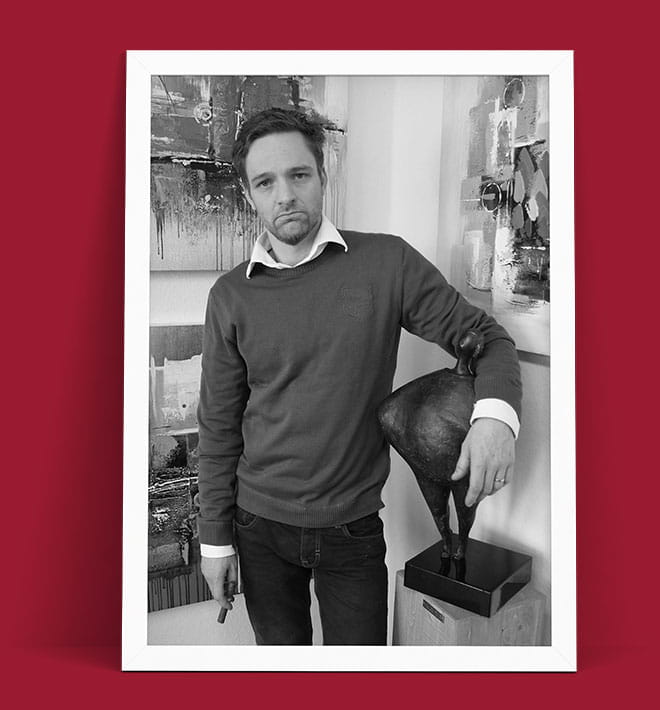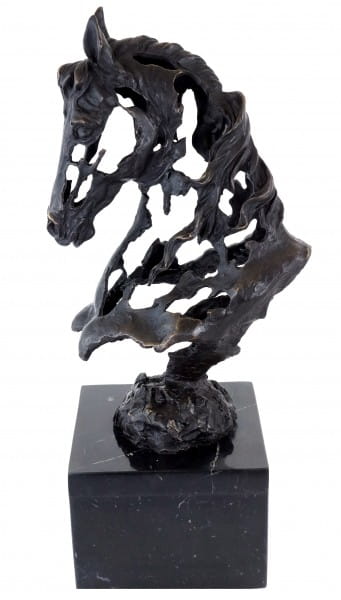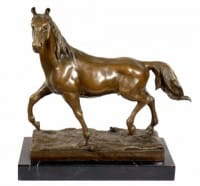€599.00 *
Prices incl. VAT, free shipping worldwide
Ready to ship today,
Delivery time appr. 3-6 workdays










Apocalyptic Horse – Bronze Statue – Signed by Martin Klein Martin Klein was born in 1979 in... more
Product description
"Bronze Horse Statue - Apocalyptic Horse - M. Klein"
| Weight | 4,8 kg |
Apocalyptic Horse – Bronze Statue – Signed by Martin Klein
Martin Klein was born in 1979 in the small Saxon town of Bischofswerda, where medieval church steeples and rolling forests filled his childhood with peace and mystery. Surrounded by the sounds of baroque churches and the whispering of pine forests, Klein sharpened his eye for dramatic forms and the play of light and shadow. While sketching peacefully grazing horses at dawn, he sensed early on that these noble creatures possessed both grace and hidden power – a duality that would become the heart of his artistic vision.
From the Dresden Studios to the Leipzig Foundries
After studying at the Dresden Academy of Fine Arts, Klein immersed himself in classical anatomy studies and the time-tested techniques of lost-wax bronze casting. He set up a modest workshop in Leipzig, where salvaged industrial lofts and high ceilings provided space for large, expressive works. It was here that Klein first developed the idea for his Horsemen of the Apocalypse, a quartet of equine forms meant to evoke the primal forces of revelation and transformation. This work in the series—simply titled "Apocalyptic Horse"—was intended to appear as a haunting vision of endurance amidst collapse.
Forging an Omen: Concept and Clay
In his Leipzig studio, Klein began sculpting a clay model that captured both anatomical rigor and otherworldly suggestion. In its final bronze form, the horse stands nearly 41.5 centimeters tall. Its head was stretched forward, its nostrils flared as if inhaling the dust of a world in disarray, its mane shredded into jagged strips that leaped back like embers in a dying fire. Every muscle fiber, every tendon beneath the skin was sculpted with the utmost care: the hollow behind the shoulder blade, the tense suspension of the fetlock joint, the engraved depressions in the flanks. Klein attempted to conjure the raw spirit of a creature born in chaos—neither entirely abstract nor merely representational, but something living on the threshold between reality and prophecy.
Lost-Wax Alchemy: From Clay to Bronze
The clay original was sealed and entrusted to a renowned foundry perched in Saxony’s Ore Mountains. There, artisans applied the lost-wax process, encasing the clay in a ceramic shell before draining and melting away the wax. Molten bronze, heated to a liquid glow of over 1,150 °C, flowed into the void, capturing every fissure of the horse’s ragged mane and the deep shadows beneath its sharply defined cheekbones. After cooling, the shell was broken away, revealing the raw bronze that would be further refined. Under Klein’s watchful eye, the sculpture underwent a rigorous phase of “chasing” to erase casting seams and to restore crisply carved details—down to the frayed edges of the horse’s ears. A layered patina followed: first, a sable wash that settled into the deepest recesses, then selective burnishing on the mane’s high points and the bridge of the nose to evoke the glint of steel in twilight.
Anatomy of Unraveling Grandeur
As a bronze horse statue, this figure stands apart in its unsettling elegance. Whereas traditional equestrian sculptures present horses in poised triumph, Klein’s creation feels as though it has galloped through storm and ruin, yet remains unbowed. The horse’s eye, a dark void surrounded by carved ridges, conveys both ancient wisdom and wariness. Its flared ribcage, suggest endurance over abundance, a creature sustained by sheer will. The fractured mane, sculpted as though it could detach and scatter on the wind, seems to burn with an inner fire. When viewed from the side, the horse’s silhouette appears almost skeletal—a sentinel emerging from shadow. Yet from a frontal perspective, one notices the gentle curve of a powerful neck and the hollow that echoes a rider’s absence.
The Third Rider Speaks of Renewal and Reckoning
Although conceived as one of four, the “Apocalyptic Horse” carries a unique resonance in Klein’s series. In traditional iconography, the third Horse often represents famine or transformation through scarcity. Klein reinterprets this symbolism: here, the horse’s gaunt form and scorched mane signify both the stripping away of illusion and the possibility that, in emptiness, there lies a seed of reinvention. It stands as a decorative horse statue that does more than adorn a shelf; it compels viewers to consider cycles of loss and rebirth, to see amid ruin moments pregnant with potential. For those familiar with Klein’s work, this horse embodies a transitional energy—neither wholly destructive nor wholly restorative, but an in-between force that heralds change.
Presence and Poise in Any Environment
On its solid black marble plinth, the “Apocalyptic Horse” finds its home in spaces both modern and traditional. In a minimalist loft, its dark, burnished patina stands in stark relief against white walls; in a study lined with leather-bound tomes, its ominous silhouette resonates with the glow of lamplight. Under a directed spotlight, shadows play across the hollowed flanks and jagged mane, evoking the flicker of ghostly embers. Although compact enough to grace a console table, it exerts a presence far larger than its footprint suggests—a reminder that bronze can channel forces as elemental as wind and fire.
A Signed Testament to Visionary Craft
Each “Apocalyptic Horse” is signed “M. Klein” along the underside, ensuring authenticity. Collectors seeking a horse statue that transcends mere representation—an artwork that bridges classical form with contemporary urgency—will find in Klein’s creation a rich, multilayered experience. Over time, its patina will mellow and evolve, deepening in crevices and gleaming on ridges, much like the changing landscape that inspired its conception. As a bronze horse statue that melds prophetic portent with sculptural splendor, it invites perpetual engagement: viewers may discover in its fractured mane and hollow gaze new reflections on resilience, reckoning, and the possibility of renewal even in the darkest of times.
Martin Klein was born in 1979 in the small Saxon town of Bischofswerda, where medieval church steeples and rolling forests filled his childhood with peace and mystery. Surrounded by the sounds of baroque churches and the whispering of pine forests, Klein sharpened his eye for dramatic forms and the play of light and shadow. While sketching peacefully grazing horses at dawn, he sensed early on that these noble creatures possessed both grace and hidden power – a duality that would become the heart of his artistic vision.
From the Dresden Studios to the Leipzig Foundries
After studying at the Dresden Academy of Fine Arts, Klein immersed himself in classical anatomy studies and the time-tested techniques of lost-wax bronze casting. He set up a modest workshop in Leipzig, where salvaged industrial lofts and high ceilings provided space for large, expressive works. It was here that Klein first developed the idea for his Horsemen of the Apocalypse, a quartet of equine forms meant to evoke the primal forces of revelation and transformation. This work in the series—simply titled "Apocalyptic Horse"—was intended to appear as a haunting vision of endurance amidst collapse.
Forging an Omen: Concept and Clay
In his Leipzig studio, Klein began sculpting a clay model that captured both anatomical rigor and otherworldly suggestion. In its final bronze form, the horse stands nearly 41.5 centimeters tall. Its head was stretched forward, its nostrils flared as if inhaling the dust of a world in disarray, its mane shredded into jagged strips that leaped back like embers in a dying fire. Every muscle fiber, every tendon beneath the skin was sculpted with the utmost care: the hollow behind the shoulder blade, the tense suspension of the fetlock joint, the engraved depressions in the flanks. Klein attempted to conjure the raw spirit of a creature born in chaos—neither entirely abstract nor merely representational, but something living on the threshold between reality and prophecy.
Lost-Wax Alchemy: From Clay to Bronze
The clay original was sealed and entrusted to a renowned foundry perched in Saxony’s Ore Mountains. There, artisans applied the lost-wax process, encasing the clay in a ceramic shell before draining and melting away the wax. Molten bronze, heated to a liquid glow of over 1,150 °C, flowed into the void, capturing every fissure of the horse’s ragged mane and the deep shadows beneath its sharply defined cheekbones. After cooling, the shell was broken away, revealing the raw bronze that would be further refined. Under Klein’s watchful eye, the sculpture underwent a rigorous phase of “chasing” to erase casting seams and to restore crisply carved details—down to the frayed edges of the horse’s ears. A layered patina followed: first, a sable wash that settled into the deepest recesses, then selective burnishing on the mane’s high points and the bridge of the nose to evoke the glint of steel in twilight.
Anatomy of Unraveling Grandeur
As a bronze horse statue, this figure stands apart in its unsettling elegance. Whereas traditional equestrian sculptures present horses in poised triumph, Klein’s creation feels as though it has galloped through storm and ruin, yet remains unbowed. The horse’s eye, a dark void surrounded by carved ridges, conveys both ancient wisdom and wariness. Its flared ribcage, suggest endurance over abundance, a creature sustained by sheer will. The fractured mane, sculpted as though it could detach and scatter on the wind, seems to burn with an inner fire. When viewed from the side, the horse’s silhouette appears almost skeletal—a sentinel emerging from shadow. Yet from a frontal perspective, one notices the gentle curve of a powerful neck and the hollow that echoes a rider’s absence.
The Third Rider Speaks of Renewal and Reckoning
Although conceived as one of four, the “Apocalyptic Horse” carries a unique resonance in Klein’s series. In traditional iconography, the third Horse often represents famine or transformation through scarcity. Klein reinterprets this symbolism: here, the horse’s gaunt form and scorched mane signify both the stripping away of illusion and the possibility that, in emptiness, there lies a seed of reinvention. It stands as a decorative horse statue that does more than adorn a shelf; it compels viewers to consider cycles of loss and rebirth, to see amid ruin moments pregnant with potential. For those familiar with Klein’s work, this horse embodies a transitional energy—neither wholly destructive nor wholly restorative, but an in-between force that heralds change.
Presence and Poise in Any Environment
On its solid black marble plinth, the “Apocalyptic Horse” finds its home in spaces both modern and traditional. In a minimalist loft, its dark, burnished patina stands in stark relief against white walls; in a study lined with leather-bound tomes, its ominous silhouette resonates with the glow of lamplight. Under a directed spotlight, shadows play across the hollowed flanks and jagged mane, evoking the flicker of ghostly embers. Although compact enough to grace a console table, it exerts a presence far larger than its footprint suggests—a reminder that bronze can channel forces as elemental as wind and fire.
A Signed Testament to Visionary Craft
Each “Apocalyptic Horse” is signed “M. Klein” along the underside, ensuring authenticity. Collectors seeking a horse statue that transcends mere representation—an artwork that bridges classical form with contemporary urgency—will find in Klein’s creation a rich, multilayered experience. Over time, its patina will mellow and evolve, deepening in crevices and gleaming on ridges, much like the changing landscape that inspired its conception. As a bronze horse statue that melds prophetic portent with sculptural splendor, it invites perpetual engagement: viewers may discover in its fractured mane and hollow gaze new reflections on resilience, reckoning, and the possibility of renewal even in the darkest of times.
Height: 41.5 cm
Width: 17 cm
Depth: 14 cm
Weight: 4.8 kg
Related links to "Bronze Horse Statue - Apocalyptic Horse - M. Klein"
Read, write and discuss reviews... more
Customer evaluation for "Bronze Horse Statue - Apocalyptic Horse - M. Klein"
Write an evaluation
Evaluations will be activated after verification.
Our advantages
free shipping
Worldwide free shipping
14 days money back
You can cancel your order
within 14 days
secure payment services
Paypal, Master Card, Visa, American Express and more
NEW
NEW
NEW
NEW
NEW


































































